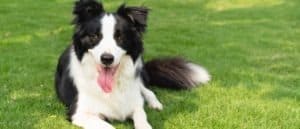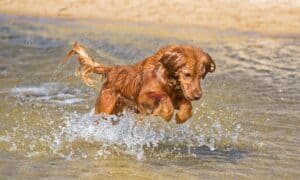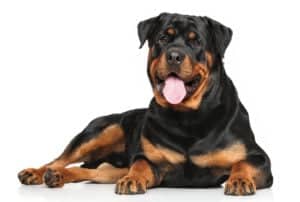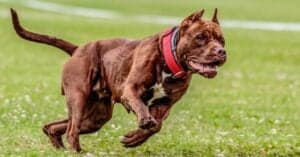Dog Paws: Everything You Wanted to Know About Your Dog’s Foot
Feet and their accompanying legs have been one of the most successful evolutionary changes in the history of natural selection. There are no known birds or land mammals that don’t have legs, and worms and snakes tend to be the evolutionary exception rather than the rule. Legs increase mobility significantly, and mobility allows animals to adapt and spread into a wider range of environments. Recent discoveries have revealed that the evolution of legs may have happened much more quickly and easily than we originally thought, and that’s given more time for animals to grow feet that match their style of locomotion.
A dog’s paws are quite similar to other mammalian tetrapods, which should come as no surprise considering that they share over 99% of their DNA with wild wolves. But the design of a dog’s paws has evolved to serve specific purposes and requires specific attention. Here’s all you need to know about how to care for your dog’s paws.
The Functionality of a Dog’s Paws

iStock.com/Rachel Lodin
If you’ve ever tried running on asphalt with bare feet, you’ll intimately understand the importance of having socks and shoes to cushion the force of impact. The pads of a dog’s paws serve a similar, albeit organic, role. Four digital pads cover each of a dog’s four toes, while a larger metacarpal pad below extends to either side of the foot’s bottom. Behind this is a smaller pad known as the carpal pad and a small claw known as the dewclaw.
The digital and metacarpal pads are where a dog places the most of its weight when moving, and they’re constructed of adipose — or fat tissue — and a layer of the skin thicker than anywhere else on the dog’s body. Elastic fibers connecting the adipose let these pads absorb and redistribute the pressure from the impact of a dog’s paws hitting a surface. Sweat glands on the pads help keep the body cool in hotter weather, while the adipose within the pads resists freezing and offers insulation against ice and snow.
The carpal pad plays a different but important role in how dogs move. Positioned approximately where the human wrist would be, the carpal pad serves a similar purpose to a car’s handbrake. It doesn’t normally touch the ground when a dog is walking or running, but adjusting the legs to scrape the carpal pad across the ground lets a dog come to a quick stop. And since it’s made from the same material as the other pads, it can significantly reduce the impact on the dog’s joints and muscles.
Dewclaws tend to be less important. Although they help a rare few dog breeds climb steep hills, they’re mostly just used to get a better grip on toys, sticks, and bones. Claws can also help with navigation, as they can be used for digging and gaining traction on looser surfaces.
The Different Types of Dog Paws
There are 360 recognized dog breeds throughout the world, and many of them have been bred specifically for unique tasks. That means that there are some major variations in the core anatomy of a dog’s paws. Kennel clubs recognize three types of paws that appear in most dog breeds.
- Hare Feet: The two center digital pads are longer than the ones on the outside, creating an elongated foot that closely resembles a hare’s feet. That means more surface area touches the ground, allowing a dog with hare feet to sprint short distances quickly but requiring an enormous amount of energy expenditure. Dogs with hare feet include the greyhound, Australian shepherd, and standard poodle.
- Webbed Feet: Just like with ducks, dogs with webbed feet have usually been bred to work in and around water. Dog breeds with webbed feet are most often retrievers like the Labrador — but dogs like the otterhound and the dachshund developed webbed feet because their prey — otters and badgers respectively — often fled into water.
- Cat Feet: Just like a cat’s feet, the digital pads are bunched closely together and the paw’s design is more compact and rounded. That smaller size lets dogs take smaller steps for less energy, and it’s thus become dominant in working class breeds. Dogs with cat feet include the Akita, Doberman pinscher, and Newfoundland.
There are a few other types of feet that appear in other breeds, though they’re rarer. American foxhounds ironically have a foot design quite similar to a fox, while malamutes have broader feet with insulating hairs that replicate the design of snowshoes, or the feet of a bobcat or lynx.
Healthy Dog Paws vs. Unhealthy Dog Paws?
Dog paws may take a lot of shapes, but the physical signs of something wrong are usually not too hard to identify. Abrasions, inflammation, cuts, burns, or sores are clear signs that there may be something wrong with your dog’s foot. Keep an eye out for thorns, rocks, or other pieces of debris that might get caught between their toes as well.
A puppy’s paw pads begin pink but will eventually darken to black as they reach adulthood. Further discoloration of pads as adults isn’t necessarily a sign of anything serious, but discoloration on the pads or the hairs around them could warrant further investigation from a veterinarian. That’s especially true if they’re experiencing other symptoms of illness or discomfort.
If your dog’s paws smell like corn chips or popcorn, that’s perfectly normal. This smell is the result of naturally occurring bacteria and fungi. The natural licking and chewing a dog does helps spread these harmless microbes. But if the smell is particularly pungent, it could indicate more serious underlying problems. A slightly calloused, cracked pad isn’t always a sign of anything more serious, and it’s commonly seen in more active dogs who use their paws often for traction.
Common Types of Dog Paw Problems
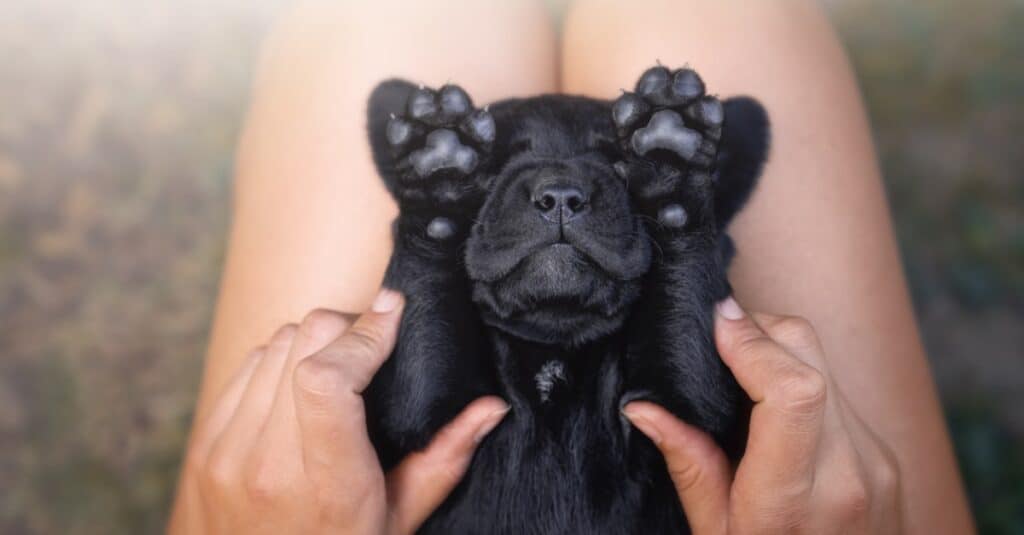
iStock.com/manushot
If your dog is having serious problems with its feet, you should get them to the veterinarian. But knowing the facts about the most common problems can help you better get your dog the care they deserve.
- Allergies represent one of the more common problems dogs have with their paws. If your dog is obsessively chewing or licking its feet, allergies are most likely to blame. Inflammation and swelling are common, and the chewing can eventually cause sores that. can lead to infections if the chewing become too serious. Allergies should be treated by a veterinarian, and common treatments include prescription drugs and medicated foot wipes that can offer protection while outdoors.
- Some level of bacteria and yeast is common in dogs, and it actually leads to the trademark corn chips smell that many dog feet have, but it’s quite common for yeast and bacteria to grow out of control. Both yeast and bacterial infections have similar symptoms: a worsening smell, discoloration around the paw’s skin or hairs, and reddening and swelling. Existing injuries or sores can become a more serious problem with an infection. Though they can be easily mistaken for one another, yeast and bacterial infections require different treatments. That means you should be sure to bring your dog to the veterinarian so they can get a closer look under a microscope and get the real facts. Seriously cracked pads may also indicate infection as a cause.
- Serious licking or limping can be a sign of injuries, which can take a number of different forms and vary in severity. But it’s important to keep an eye out even for minor injuries on this part of the anatomy like rocks caught between the toes and small sores and cuts. Limping can also indicate burns or something stuck in the skin like a splinter. Minor injuries may be treated with disinfectant and monitoring, but always err on the side of caution if you think an injury may need medical attention.
- A dog’s claws are different from a human’s nails in that they have nerves and blood vessels inside them. Ingrown or cracked toenails should be treated as a priority, and they might require either grooming or medical attention depending on how serious they are.
Routine Maintenance For Your Dog’s Paws
It’s important to be able to identify when a dog’s having issues with its paws, but prevention is often the best medicine. Adopting habits that reduce the threat of paw injury and keeping up with routine maintenance can help reduce problems with your dog’s paws in the first place. The facts show that regular grooming practices and the regular inspection of your dog’s foot anatomy can offer them protection against the worst conditions. Walking dogs regularly helps maintain circulation to the pads, and you can also improve circulation by giving them regular massages. Cracked pads are often a natural result of being used to offer traction when running, but they can be ameliorated by administering hydrating lotions during your regular grooming. Hair on the feet often serves a vital purpose of insulation from the cold and protection from water, but they can be trimmed and tucked between the paw pads if they become cumbersome.
Nails should similarly be kept trimmed, and you can always rely on the services of a groomer if you’re worried about cutting a claw to the quick. A dog will often try to hide signs of injuries like limping by instinct, so it’s important to make scheduled check-ins for your dog’s paws a regular thing. A dog’s paws offer innate insulation against the cold and protection against heat, but that doesn’t mean that they’re fine walking in any conditions. Proper hydration can help keep your dog comfortable — but show care by keeping your dog off the pavement during particularly hot days, and consider getting booties if you live somewhere with particularly harsh winters.
Next up: How Does A Caterpillar Turn Into a Butterfly?
Ready to discover the top 10 cutest dog breeds in the entire world?
How about the fastest dogs, the largest dogs and those that are — quite frankly — just the kindest dogs on the planet? Each day, AZ Animals sends out lists just like this to our thousands of email subscribers. And the best part? It’s FREE. Join today by entering your email below.
More from A-Z Animals
Feet and their accompanying legs have been one of the most successful evolutionary changes in the history of natural selection. There are no known birds or land mammals that don’t have legs, and worms and snakes tend to be the evolutionary exception rather than the rule. Legs increase mobility significantly, and mobility allows animals to adapt and spread into a wider range of environments. Recent discoveries have revealed that the evolution of legs may have happened much more quickly and easily than we originally thought, and that’s given more time for animals to grow feet that match their style of locomotion.
A dog’s paws are quite similar to other mammalian tetrapods, which should come as no surprise considering that they share over 99% of their DNA with wild wolves. But the design of a dog’s paws has evolved to serve specific purposes and requires specific attention. Here’s all you need to know about how to care for your dog’s paws.
The Functionality of a Dog’s Paws

iStock.com/Rachel Lodin
If you’ve ever tried running on asphalt with bare feet, you’ll intimately understand the importance of having socks and shoes to cushion the force of impact. The pads of a dog’s paws serve a similar, albeit organic, role. Four digital pads cover each of a dog’s four toes, while a larger metacarpal pad below extends to either side of the foot’s bottom. Behind this is a smaller pad known as the carpal pad and a small claw known as the dewclaw.
The digital and metacarpal pads are where a dog places the most of its weight when moving, and they’re constructed of adipose — or fat tissue — and a layer of the skin thicker than anywhere else on the dog’s body. Elastic fibers connecting the adipose let these pads absorb and redistribute the pressure from the impact of a dog’s paws hitting a surface. Sweat glands on the pads help keep the body cool in hotter weather, while the adipose within the pads resists freezing and offers insulation against ice and snow.
The carpal pad plays a different but important role in how dogs move. Positioned approximately where the human wrist would be, the carpal pad serves a similar purpose to a car’s handbrake. It doesn’t normally touch the ground when a dog is walking or running, but adjusting the legs to scrape the carpal pad across the ground lets a dog come to a quick stop. And since it’s made from the same material as the other pads, it can significantly reduce the impact on the dog’s joints and muscles.
Dewclaws tend to be less important. Although they help a rare few dog breeds climb steep hills, they’re mostly just used to get a better grip on toys, sticks, and bones. Claws can also help with navigation, as they can be used for digging and gaining traction on looser surfaces.
The Different Types of Dog Paws
There are 360 recognized dog breeds throughout the world, and many of them have been bred specifically for unique tasks. That means that there are some major variations in the core anatomy of a dog’s paws. Kennel clubs recognize three types of paws that appear in most dog breeds.
- Hare Feet: The two center digital pads are longer than the ones on the outside, creating an elongated foot that closely resembles a hare’s feet. That means more surface area touches the ground, allowing a dog with hare feet to sprint short distances quickly but requiring an enormous amount of energy expenditure. Dogs with hare feet include the greyhound, Australian shepherd, and standard poodle.
- Webbed Feet: Just like with ducks, dogs with webbed feet have usually been bred to work in and around water. Dog breeds with webbed feet are most often retrievers like the Labrador — but dogs like the otterhound and the dachshund developed webbed feet because their prey — otters and badgers respectively — often fled into water.
- Cat Feet: Just like a cat’s feet, the digital pads are bunched closely together and the paw’s design is more compact and rounded. That smaller size lets dogs take smaller steps for less energy, and it’s thus become dominant in working class breeds. Dogs with cat feet include the Akita, Doberman pinscher, and Newfoundland.
There are a few other types of feet that appear in other breeds, though they’re rarer. American foxhounds ironically have a foot design quite similar to a fox, while malamutes have broader feet with insulating hairs that replicate the design of snowshoes, or the feet of a bobcat or lynx.
Healthy Dog Paws vs. Unhealthy Dog Paws?
Dog paws may take a lot of shapes, but the physical signs of something wrong are usually not too hard to identify. Abrasions, inflammation, cuts, burns, or sores are clear signs that there may be something wrong with your dog’s foot. Keep an eye out for thorns, rocks, or other pieces of debris that might get caught between their toes as well.
A puppy’s paw pads begin pink but will eventually darken to black as they reach adulthood. Further discoloration of pads as adults isn’t necessarily a sign of anything serious, but discoloration on the pads or the hairs around them could warrant further investigation from a veterinarian. That’s especially true if they’re experiencing other symptoms of illness or discomfort.
If your dog’s paws smell like corn chips or popcorn, that’s perfectly normal. This smell is the result of naturally occurring bacteria and fungi. The natural licking and chewing a dog does helps spread these harmless microbes. But if the smell is particularly pungent, it could indicate more serious underlying problems. A slightly calloused, cracked pad isn’t always a sign of anything more serious, and it’s commonly seen in more active dogs who use their paws often for traction.
Common Types of Dog Paw Problems

iStock.com/manushot
If your dog is having serious problems with its feet, you should get them to the veterinarian. But knowing the facts about the most common problems can help you better get your dog the care they deserve.
- Allergies represent one of the more common problems dogs have with their paws. If your dog is obsessively chewing or licking its feet, allergies are most likely to blame. Inflammation and swelling are common, and the chewing can eventually cause sores that. can lead to infections if the chewing become too serious. Allergies should be treated by a veterinarian, and common treatments include prescription drugs and medicated foot wipes that can offer protection while outdoors.
- Some level of bacteria and yeast is common in dogs, and it actually leads to the trademark corn chips smell that many dog feet have, but it’s quite common for yeast and bacteria to grow out of control. Both yeast and bacterial infections have similar symptoms: a worsening smell, discoloration around the paw’s skin or hairs, and reddening and swelling. Existing injuries or sores can become a more serious problem with an infection. Though they can be easily mistaken for one another, yeast and bacterial infections require different treatments. That means you should be sure to bring your dog to the veterinarian so they can get a closer look under a microscope and get the real facts. Seriously cracked pads may also indicate infection as a cause.
- Serious licking or limping can be a sign of injuries, which can take a number of different forms and vary in severity. But it’s important to keep an eye out even for minor injuries on this part of the anatomy like rocks caught between the toes and small sores and cuts. Limping can also indicate burns or something stuck in the skin like a splinter. Minor injuries may be treated with disinfectant and monitoring, but always err on the side of caution if you think an injury may need medical attention.
- A dog’s claws are different from a human’s nails in that they have nerves and blood vessels inside them. Ingrown or cracked toenails should be treated as a priority, and they might require either grooming or medical attention depending on how serious they are.
Routine Maintenance For Your Dog’s Paws
It’s important to be able to identify when a dog’s having issues with its paws, but prevention is often the best medicine. Adopting habits that reduce the threat of paw injury and keeping up with routine maintenance can help reduce problems with your dog’s paws in the first place. The facts show that regular grooming practices and the regular inspection of your dog’s foot anatomy can offer them protection against the worst conditions. Walking dogs regularly helps maintain circulation to the pads, and you can also improve circulation by giving them regular massages. Cracked pads are often a natural result of being used to offer traction when running, but they can be ameliorated by administering hydrating lotions during your regular grooming. Hair on the feet often serves a vital purpose of insulation from the cold and protection from water, but they can be trimmed and tucked between the paw pads if they become cumbersome.
Nails should similarly be kept trimmed, and you can always rely on the services of a groomer if you’re worried about cutting a claw to the quick. A dog will often try to hide signs of injuries like limping by instinct, so it’s important to make scheduled check-ins for your dog’s paws a regular thing. A dog’s paws offer innate insulation against the cold and protection against heat, but that doesn’t mean that they’re fine walking in any conditions. Proper hydration can help keep your dog comfortable — but show care by keeping your dog off the pavement during particularly hot days, and consider getting booties if you live somewhere with particularly harsh winters.
Next up: How Does A Caterpillar Turn Into a Butterfly?
Ready to discover the top 10 cutest dog breeds in the entire world?
How about the fastest dogs, the largest dogs and those that are — quite frankly — just the kindest dogs on the planet? Each day, AZ Animals sends out lists just like this to our thousands of email subscribers. And the best part? It’s FREE. Join today by entering your email below.




